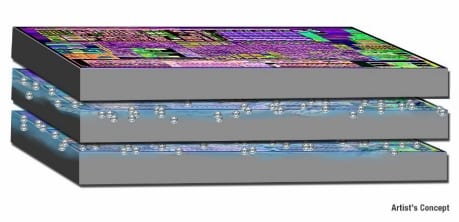DARPA researchers trying embedded water droplets cooling tech for processorsIf this happens, you will neither need an air nor a water coolerAre hot spots becoming an increasing problemWill Intel or AMD be able to adopt such a feature inside its processors
Are hot spots becoming an increasing problem
Even though Intel has introduced chips that possess lowered clock frequencies, hot spots are still an issue because of transistor density, which has continued to increase. This ultimately means that more transistors are packed into a smaller space, giving them less breathing room to remove all that heat. Additionally, CPU voltage has stopped scaling. Unfortunately, you still require a minimum amount of voltage to power on a transistor and if you decide to gain some additional performance, you will have to provide the CPU with increments of that voltage, something that is actually harmful if not done properly. At the end of the day, modern chips have a smaller voltage range, at least in absolute terms in comparison to their predecessors. To improve thermal performance, the project took roughly four years and has now started to show some promising results. Teaming up with Lockheed Martin, the team summarized the following: Lockheed Martin will be looking to integrate its own technology with Qorvo, which uses Gallium Nitride (GaN) technology and builds radios and RF equipment. With results looking thoroughly promising, it appears that microfluidic cooling is definitely possible. However, one question remains to be asked.
Will Intel or AMD be able to adopt such a feature inside its processors
It is definitely possible, but it will still be a challenge for them because firstly, if both companies decide to do the work themselves, then it will present some serious challenge, mainly towards placing an on-die cooling solution. Naturally, before such a product can be shipped out to the masses, extensive costs concerning prototyping, validating, and designing compatible hardware across the entire PC ecosystem will have to be carried out. While it is definitely possible, we honestly doubt that Intel and AMD would consider such a project, seeing as how they have other things to worry about.
